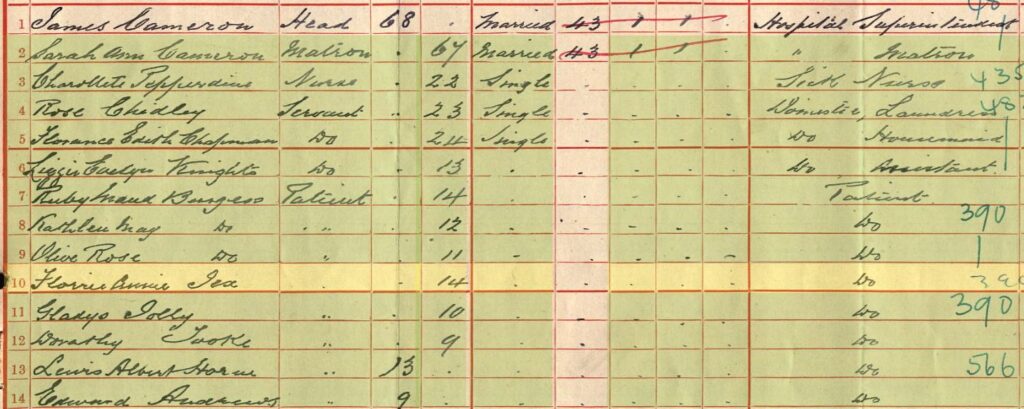Edith’s mother, Ellen Hovells, married Alfred Jex in 1921. His first wife, also named Ellen, died in 1919. She had spent the last ten years of her life in the Suffolk County Asylum.
Dennis George Aldous
Born: 17 NOV 1919 in Halesworth, Suffolk County, England
Father: Dennis Edward Aldous (1897 to 1970)
Mother: Florence Edith May Whiting (1891 to 1963)
Spouse: Edith Hovells (1911 to 2001)
Married: 1947 in Lowestoft, Suffolk County, England
Children: None
Died: 1989 in Great Yarmouth, Norfolk County, England
Timeline:
1947 Marriage to Edith
1960 Death of sister, Evelyn
1963 Death of mother, Florence
1970 Death of father, Dennis
1989 Death and Burial
Occupation: unknown
Records:
England & Wales, Birth Index: 1916-2005
England & Wales, Marriage Index: 1916-2005
England & Wales, Death Index: 1916-2005
Variations of Surname: none
Spouse:
Edith Hovells:
Edith was born on 14 MAR 1911 in Oulton Broad, Suffolk County, England. She died on 1 APR 2001 in Gorleston, Suffolk County, England.
Edith was born out of wedlock to Ellen Hovells.
Ellen Hovells was born on 4 FEB 1882 in Lound, Suffolk County, England. She died in 1961 in Lowestoft, Suffolk County, England.
Ellen married Alfred Charles Jex in 1921 in Great Yarmouth, Norfolk County, England. Alfred was 24 years older than Ellen. No known children were born to this marriage.
Alfred Charles Jex was born on 16 APR 1858 in Starston, Norfolk County, England. He died in 1946 in Lowestoft, Suffolk County, England.
Alfred had previously married Ellen Wicks in 1884 in Lowestoft, Suffolk County, England. Five known children were born to this marriage:
Salome Jex (1885)
Arthur William Jex (1886)
Edward Walter Jex (1887 to 1891)
Clara Jex (1888 to 1894)
Florence Annie Jex (1897)
Ellen Wicks was born in 1861 in Debenham, Suffolk County, England. She died on 14 APR 1919 in Melton, Suffolk County, England.
What Happened in 1911?
As I was building Alfred’s profile on Ancestry.com, I found him on the 1911 England census. He was living alone in Oulton Broad, Suffolk County, England.

I thought that was a bit odd. Maybe his wife and children were off visiting a relative at that time. Alfred’s entry on the census indicated that he was still married. It also showed that three of the five children were still living at the time the census was enumerated.
But, where were Ellen and the three surviving children? I decided to do a little more research and discovered the following:
Alfred’s wife, Ellen Wicks Jex:
In 1911, Alfred’s wife was an inmate of the Suffolk County Asylum in Melton, Suffolk County, England. This parish is 38 miles southwest of Oulton Broad, Suffolk County, England.
The UK, Lunacy Patients Admission Registers, 1846-1912 had two entries for Ellen:
She was first admitted on 12 JUL 1907 and discharged four months later on 21 NOV 1907.
![]()
The second time Ellen was sent to the asylum was on 27 MAR 1909. She remained an inmate of the Suffolk County Asylum until her death on 14 APR 1919.
![]()
As you can see on the 1911 England census, inmates were recorded only by their first and last initials. The census takers may have done this to protect people’s privacy.

Alfred’s oldest daughter, Salome Jex:
In 1911, Alfred’s oldest daughter was also an inmate of the Suffolk County Asylum in Melton. She was admitted on 22 MAR 1911 and remained there for six months. She was discharged on 22 SEP 1911.
![]()
Again, the 1911 England census records list only her first and last initials.

Salome went on to marry George William Layton in 1915 in Lowestoft, Suffolk County, England. After he died in 1931, Salome married a man named Arthur T Tomlin in 1948.
Alfred’s son, Arthur William Jex:
The 1911 England census shows that Arthur was a baker and confectioner. His shop was located at 82 Beaconsfield Road in Lowestoft, Suffolk County, England. Arthur had married Ellen Thurza Peck a few months before the census was enumerated.

Alfred’s youngest daughter, Florence Annie Jex:
The 1911 England census shows that Florrie was a patient at the Oulton Broad Isolation Hospital. It could be that she had a contagious disease like measles or smallpox that required her to be separated from other family members.

Florrie went on to marry Arthur Baden Ernest Bye in 1925 in Lowestoft, Suffolk County, England.
Notes:
Here are some links to websites that helped with my Aldous family research:
Aldous.net (Aldous family history and family tree)
Ancestors of Tim Farr, Descendants of Stephen Farr (family tree)
Reid-Schroeder Genealogies (family tree)
The Tree of Us (family tree)
Family Search (family tree website)
The Internet Surname Database (surname meaning and origins)
House of Names (coat of arms)
Creating Your Family Tree
Interested in building a great family tree? Remember these important steps:
Look in your photo albums. You may have old pictures that your parents or grandparents gave you. Or, ask them for copies of photos that they have in their possession. Many people will write names and dates on the backs of photographs. Letters, diaries, and family bibles are also an excellent source for vital records.
Talk to your older relatives to find out about your ancestry. They may relate stories about an ancestor that you can add to your family tree. Family history is usually not found in newspapers. It is more of a verbal memory passed down from generation to generation.
Find the right family tree builder that suits your needs. You can choose one that has a paid subscription like Ancestry.com. There are also free sites like FamilySearch.org.
When you start building your family tree, add documentation to your ancestor’s profile. Records should include birth, marriage, death, census, military, city, and county directory listings. Any information that you can find will help create a life story about your ancestor.
If you have a unique surname, you may find databases on the internet that are useful in your search. I use SurnameDB.com for my English surnames. There are other websites on the internet for countries like Italy and Germany.
Genealogy is the study of a person’s “line of descent.” As you create your family tree, you would start with one individual and go “back into time.” You would add their parents, grandparents, and so on. There are also family trees that go “forward into time.” Many of these family trees start with a famous person, such as a president or royalty. They would then move forward into the present time. The purpose of this type of pedigree is to establish a person’s bloodline to that famous person.
There is no limit on how big your family tree can grow. The blank canvas is there for you to use. Cherish your family history, and it will be there for generations to come!



Leave a Reply